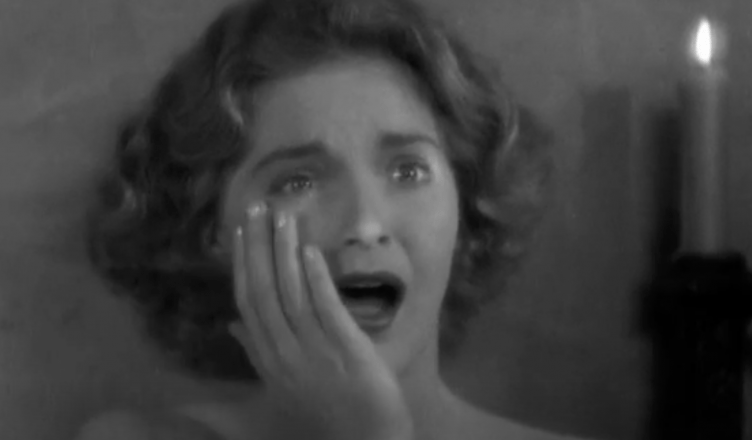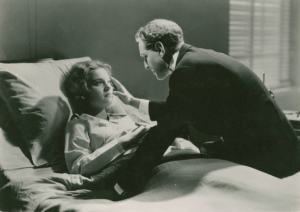Film Deets:
Director: Lambert Hillyer
Screenplay: Henry Farrell
Actress: Nan Grey
Category: Coded Queerness
Themes: Queer Monsters, Vampires
Why do these screams matter?
Dracula’s Daughter traces the struggle of Hungarian Countess Marya Zaleska (Gloria Holden) who, upon learning of the death of her father Count Dracula, believes the curse of her being a vampire will be lifted. When her hope is not fulfilled, she enlists the assistance of psychiatrist Dr. Jeffrey Garth (Otto Kruger) whom she believes has the power to cure her. When his help, too, proves ineffectual, Marya flees to Transylvania intent on turning Garth into a vampire and her everlasting companion. At least that’s the official description of the film. To many viewers, though, Dracula’s Daughter is the story of a woman desperately trying to rid herself of the “curse” of lesbianism.
In this scene, Sandor (Irving Ptchel), Marya’s manservant, has forced the young and impoverished Lili (Nan Grey) into his mistresses’ lair under the guise that Lili will model for Marya and will be rewarded with food. But as Lili undresses, she becomes increasingly wary of Marya’s intentions.
Lili’s scream here is a direct response to being confronted with Marya’s monstrosity. But it’s a monstrosity cloaked in seduction. The camera lingers on Marya as she gazes upon Lili’s exposed body and it’s clear that the sight of the undressed woman is awakening Marya’s appetites. As Lili’s awareness of what is about to transpire draws closer and Marya’s hypnotism begins to render Lili’s body immovable, a scream is Lili’s only recourse. It is a vocal rejection of what is about to transpire and that pronounced rejection is by design. It is intended to remind us that Lili is an innocent who has absolutely no interest in what is about to happen.
This casting of innocent versus monster plays very specifically upon late 1930’s sensibilities regarding sex. In the 1920s and the early part of the 1930s, sexual liberation, including queer sexuality, was a part of the cultural conversation. Nightclubs and cabarets, often dubbed “Pansy Parlors,” were popping up in cities across the country. But these open celebrations of sexuality were brought to a halt by the country’s economic decline. With the Depression also came an American religious revival in which overt depictions of homosexual desire were no longer welcomed in the mainstream. As voices that countered heteronormativity were systematically erased, even the suggestion of queer desire was to be avoided. Consequently, any inference that Lili might return Marya’s interest had to be avoided, an objective accomplished via Marya’s use of hypnosis and Lili’s scream.
This second scream can be read as a continuation of sorts. Having been rendered comatose from her encounter with Marya, doctors use their own form of hypnosis to awaken Lili so that they can find out what happened to her.
It’s important to note that Lili’s scream here does not exist in a vacuum. Instead, it essentially serves as a climax to a queer narrative that the film has been methodically building in its dialogue. Because Marya has expressed her desire to “live a normal life now, think normal things” and because she responds to Dr. Garth’s concerns that she is concealing the truth about herself with an admission that the truth is simply too ghastly to admit, audiences of the era might begin to guess that the secret Marya is guarding more likely concerns sexual desire than vampirism. The introduction of additional medical professionals in this scene is intentional. Horror films of the era used medical doctors as a means of painting monsters as threatening. Here, their presence is designed to not only to cure Lili but to return her to heterosexual normality. Lili literally dies while screaming because the encounter with Marya is no longer repressed. And that knowledge is simply too horrible a burden. Lili’s scream reminds the audience that Marya’s “diseased” mind is not only a threat to her livelihood but also to the virtue of young and impressionable women like Lili.
Works Cited
Dracula’s Daughter. Directed by Lambert Hillyer, performances by Gloria Holden, Nan Grey, and Marguerite Churchill, Universal Pictures, 1936.
Fleeson, Lucinda. “The Gay ’30s.” Chicago, 27 June 2007, www.chicagomag.com/Chicago-Magazine/November-2005/The-Gay-30S/
Pruitt, Sarah. “How Gay Culture Blossomed During the Roaring Twenties.” History, 12 June 2019, www.history.com/news/gay-culture-roaring-twenties-prohibition





